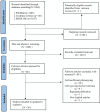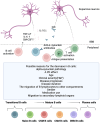Aberrations in peripheral B lymphocytes and B lymphocyte subsets levels in Parkinson disease: a systematic review
- PMID: 40230858
- PMCID: PMC11994702
- DOI: 10.3389/fimmu.2025.1526095
Aberrations in peripheral B lymphocytes and B lymphocyte subsets levels in Parkinson disease: a systematic review
Abstract
Objective: The association of B lymphocytes and B lymphocyte subsets and Parkinson's disease (PD) is increasingly acknowledged. However, there is inconsistence in the alterations of B lymphocytes or B lymphocyte subsets in peripheral blood of PD patients. To comprehensively understand its changes in PD patients,it is necessary to conduct a systematic review on this subject.
Methods: PubMed, Cochrane Library, and MEDLINE databases were searched until 3rd February 2024.
Results: We included 20 studies (n=2658) to conduct this systematic review. We conducted a qualitative analysis to assess the alterations of B lymphocytes and B lymphocyte subsets in the peripheral blood of individuals with PD. And studies reviewed demonstrated a significant decrease in the number of B cells, as well as immune dysregulation in the B lymphocyte subsets of these patients' peripheral blood.
Conclusion: Studies reviewed demonstrated that PD is linked to abnormalities in B lymphocytes and/or B lymphocytes subsets in peripheral blood. This study provides a novel perspective into the pathogenesis of PD, and future investigations into the B lymphocytes and/or B lymphocyte subsets as biomarkers and therapeutic targets for PD is warranted.
Keywords: B lymphocyte; B lymphocyte subsets; Immunity; Inflammation; Parkinson’s disease; Pathogenesis.
Copyright © 2025 Ma, Wang, Yu, Zhai and Yan.
Conflict of interest statement
The authors declare that the research was conducted in the absence of any commercial or financial relationships that could be construed as a potential conflict of interest.
Figures


References
-
- Feigin VL, Nichols E, Alam T, Bannick MS, Beghi E, Blake N, et al. . Global, regional, and national burden of neurological disorders, 1990-2016: a systematic analysis for the Global Burden of Disease Study 2016. Lancet Neurol. (2019) 18:459–80. doi: 10.1016/S1474-4422(18)30499-X - DOI - PMC - PubMed
-
- Steinmetz JD, Seeher KM, Schiess N, Nichols E, Cao B, Servili C, et al. . Global, regional, and national burden of disorders affecting the nervous system, 1990-2021: a systematic analysis for the Global Burden of Disease Study 2021. Lancet Neurol. (2024) 23:344–81. doi: 10.1016/S1474-4422(24)00038-3 - DOI - PMC - PubMed
Publication types
MeSH terms
Substances
LinkOut - more resources
Full Text Sources
Medical
Miscellaneous

